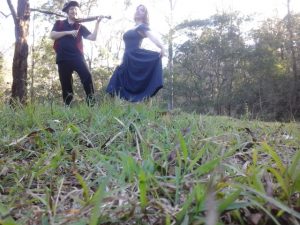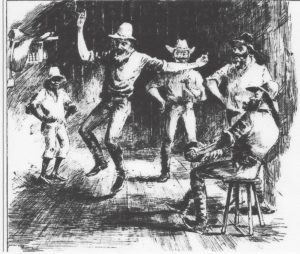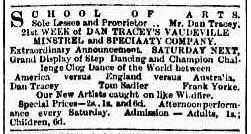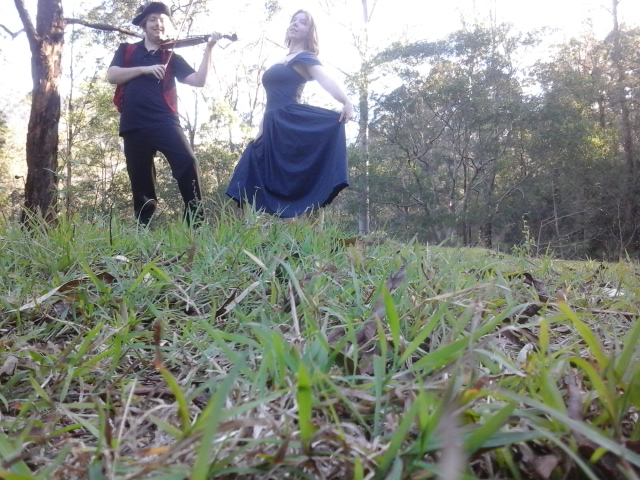Traditional step dancing in Australia
The Australian bush tradition is rich in collected step dance tunes. References to step dancing come from our earliest records with Captain Cook’s crew, sailors with the First Fleet, and convicts in the fledgling settlement.
In the 1820s, ‘shuffling the brogue’ was one of the prime recreations in the 54 licensed public houses in Sydney. Often public houses were not purpose built, but rather the front room of a private dwelling given over to the business of selling food and drink, and providing an important social hub. The chairs and tables were arranged around the edges of the room, leaving the centre free for dancing, however the space was usually limited – perfect for step dancing rather than for large group dances.
Step dance is the natural response to inspiring music: tapping out the rhythm of the tune with your feet. This was predominantly a working class mode of dance which was discouraged in polite society and in the ballroom due to its noisy and percussive nature. It is an informal, improvised style which can be danced anywhere. Even instrumental music is not essential as the tune can be held in the dancer’s mind or whistled or sung. It’s best danced on a wooden floor with footwear which will generate a robust sound – leather shoes, hobnail boots or clogs are ideal. Accounts describe people dancing on barrels, fence posts, cellar flaps, and special step boards as well as more regular places like woolsheds and pubs.
Throughout the colonial era and into the beginning of the 1900s, step dance continued to be a popular pastime. Shearers, bullockies, bush-rangers, country bumpkins, and larrikins in the big smoke, all enjoyed “a bit of a step”. Women also engaged in step dance, though not so publicly.
Searching for the dance
In the 1950s, when collectors began recording our folk music, they found a wealth of step dance tunes. Unfortunately, few of the dances were recorded. Shirley Andrews, the pioneer of folk dance research in Australia, felt that step dance was a male-dominated culture (although this wasn’t always the case) and decided not to study this area. She regretted this decision later in her life and was very supportive of my efforts to research the subject. However, it wasn’t just in Australia that step dancing failed to be collected: in England, the founding father of the folk revival, Cecil Sharp early in the twentieth century, didn’t feel the need to record the social stepping he encountered because it was so commonplace – a hundred years later it had all but vanished.
I have been researching this subject for over 30 years, receiving a grant from the Australian Folk Trust in 1993, and providing workshops at Festivals and folk gatherings over this time. This research focused on the more formal aspects of step dance such as the Irish Jig, Sailor’s Hornpipe and English clog dances, all of which had been extremely popular in Australia.
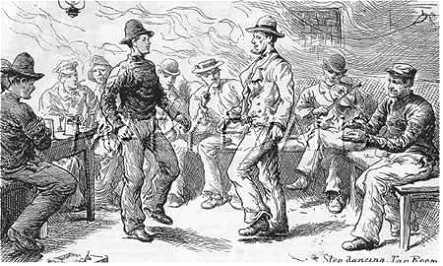
1887 Step dancing in Norfolk, England. A scene also common throughout Australia at this time. Courtesy of the Mary Evans Picture Library.
In May 2016, I became aware, through the work of Jo and Simon Harmer, that improvised step dancing had been a mainstream recreation throughout England until the 1940s and is still preserved as a living tradition in East Anglia and Dartmoor. I had believed that this form of step dance only existed in Scottish and Irish (as Sean-nós) communities, so to discover it is also unmistakably English is an important revelation with significant implications for Australian dance history.
Chronicles
Here is a small sample from a much larger collection of advertisements and anecdotes about step dancing in Australia.
THE SCALPERS’ BALL.
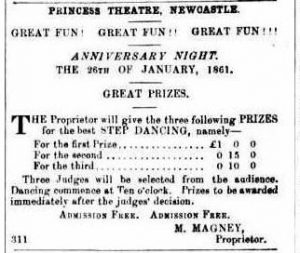
Step dancing at Princess Theatre, Newcastle 1861. Maitland Mercury and Hunter River General Advertiser
One never now hears of the “scalpers'” ball, and yet it was one of the fixtures of the outback …. Scalping was a definite calling then. It had its regular followers, just the same as shearing, fencing, or droving…. “Scalpers” implies that the men were only after the scalps of animals, but the term embraced the big army of kangaroo shooters, “possum chokers”, bear hunters, and suchlike, and it was the skin that was wanted. Probably the finest shots in the world with rifle or gun could be found amongst the “scalpers” of the outback camps.
However, to get back to the scalpers’ ball. The music supplied was mostly that of the concertina or accordion. Sometimes an old fashioned fiddle would come to light, and it was wonderful how some of those old chaps would enjoy those old-time quadrilles, lancers,mazurkas, polkas, and schottisches and waltzes, but enjoy them they did. The master of ceremonies was generally some dandv trapper, a real lady killer…. and he was generally the best dancer, and his word was law in the dance room….
The dancing was sandwiched with recitations and bush songs or probably some of the old fellows, and even the young fellows, would give a step dance between the other entertainments. In those days step dancing was wonderfully popular out West, and contests were held between champion step dancers of one faction against another faction. So it was with the scalpers.
They had their champion step dancers, their champion waltzers, and suchlike, and
at the annual ball there was always plenty of money to back these champions against all-comers, and very often the matches or contests would spread over a series of dance nights until the final champion-ship mopped up all the money. Then the contests would stop.
The decision of who was the best dancer would generally be left over until the next year. I don’t remember who was the actual champion dancer amongst the ‘possum trappers, and it is too late to worry over it now.
Romance of the West. (1924, May 17). The Brisbane Courier (Qld. : 1864 – 1933), p. 19. Retrieved September 25, 2016,
from http://nla.gov.au/nla.news-article20732850
Traces
We have few remaining traces of the dance in Australia, despite the great wealth of reports, anecdotes and collected step dance tunes. The three examples we have (to date), are clearly consistent with the styles manifest in England, Scotland and Ireland. The first video shows the late Paddy Dawson of Franklin, Tasmania, demonstrating his step dancing to the collector Rob Willis.
Rob Willis of the Oral History and Folklore Collections, National Library of Australia, writes:
This is the only example of step dancing from a traditional performer I have ever filmed.
The Dawson family of Franklin have been recorded extensively by both the National Library of Australia and other individuals in Tasmania. This sequence was shot on a couple of visits to the Dawsons, (Edie and Paddy), the first in their home (apologies for shaky footage – a bit crowded) and the second in the Franklin Hall where in the company of Peter Ellis and a keen group of Tasmanian dancers (big thanks!) we reconstructed many of the ‘lost’ dances of Tasmania.
Paddy was well in to his eighties when we filmed and although he was very enthusiastic we had to take in to consideration his age and fitness. The sequence in the Franklin Hall best demonstrates elements of his style even though he noticeably tires toward the end. Many thanks to the Dawson family for their contribution to the preservation of Tasmania’s folklore and heritage.
The second example comes from country Victoria: Maureen’s Irish shuffle collected by Peter Ellis in 1998. Peter can be seen joining in the second half of the video.
A third example comes again from Tasmania as danced at house parties on the East Coast of Tassie. This video was produced by Rob Willis in 1994 while recording musician John Sturzacker. John’s daughter, Sandra, remembered several unique dances that she learnt as a child from older members of her family. Sandra demonstrated this step dance and also a very energetic Cobblers Dance, known as the frog dance in other regions.
Collected tunes
Any tune can be used for step dancing, though those with strong rhythms are more driving than others. The two volumes of Folk Songs of Australia have a number of tunes listed and accompanying information.
Between 1953 and 1961, John Meredith collected two tunes specifically identified as a step dance tunes from the notable musician, Sally Sloane. You can hear a recording of Sally playing the tune on the National Library of Australia website
http://nla.gov.au/nla.obj-214802380/listen/0-0~0-95
Ian Hayden has a transcription of the tune on his website
The Music of Sally Sloane
https://sallysloane.wordpress.com/tunes/step-dance/
Sally also labelled Harvest Home as a breakdown or step dance tune
http://nla.gov.au/nla.obj-214819494/listen/0-486~0-555
Transcription https://sallysloane.wordpress.com/tunes/harvest-home/
A number of tunes in Sally’s repertoire have been identified as commonly used step dance tunes including St Patrick’s Day in the Morning, The Blackbird, Ring the Bell Watchman, Garryowen and various untitled jigs and hornpipes in the collection.
A selection of step dance tunes is available on the Bush Traditions website:
George Cadman One Step
Jacko’s 1st Kiama Hornpipe
Jacko’s 2nd Kiama Hornpipe
Step It Out Mary
Uncle Adam Ebert’s
Schaefer’s Half Figure
Reviving the tradition
This dance form is fun and easy to learn. It’s completely informal with no set routines to remember. The basics can be learnt in ½ hour and can be used not only bush dance, but in other dance forms currently popular in Australia such as contra and Irish set dancing.
We are happy to provide workshops for both the music and dance.
Links to related step dancing sites
Instep Research Team
Step and clog dance research, based in UK.
East Anglian Traditional Music Trust
In East Anglia, step-dancing survives outside the rarefied air of the folk festival and club, and is still danced freestyle in pubs and village halls wherever there’s some music.
Devon and Dartmoor Stepdancing
Promoting a healthy and vibrant living tradition.
Edinburgh University Dance Society
Scottish step-dancing is a traditional Scottish form of hard-shoe dancing.
Step Dancing: why we should learn from past mistakes.
An insight into the step dancing tradition in Scotland.
Traditional Irish step dancing
Sean-nós in Irish Gaelic means “old style”. Sean-nós dance is the old traditional form of dance characterised by its low to the ground footwork, improvised steps, free movement of the arms, and an emphasis upon a battering step (which sounds out more loudly the accented beat of the music).
______________________________________________________________
The information on this website www.historicaldance.au may be copied for personal use only, and must be acknowledged as from this website. It may not be reproduced for publication without prior permission from Heather Clarke.
